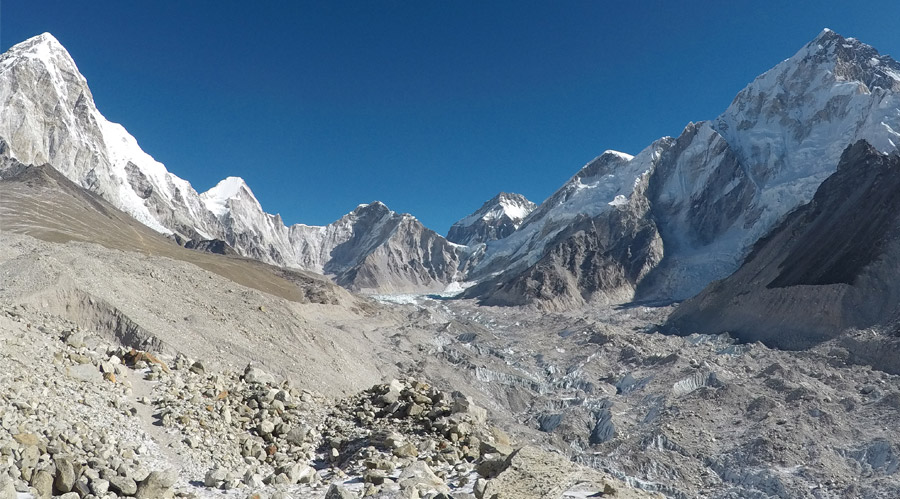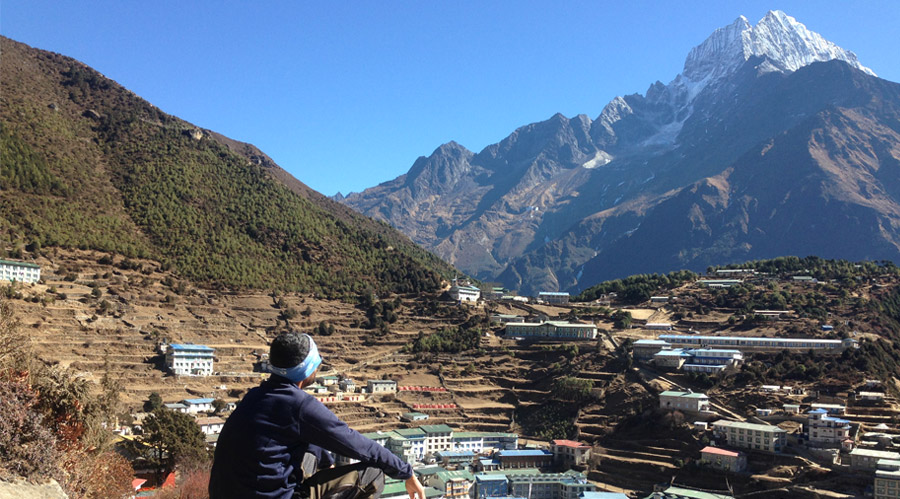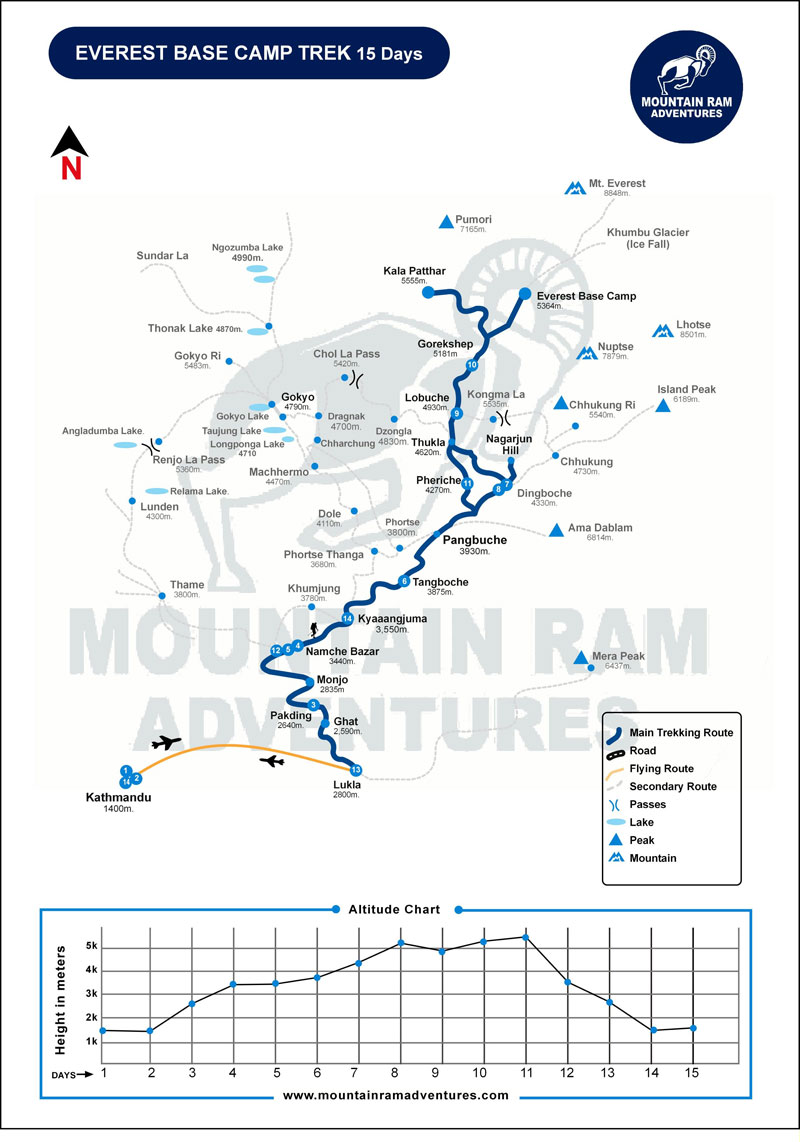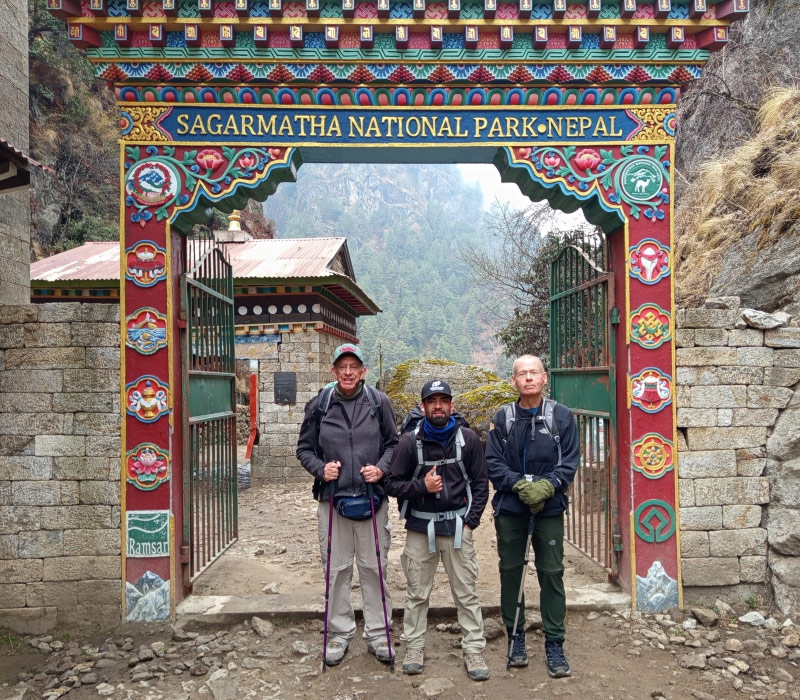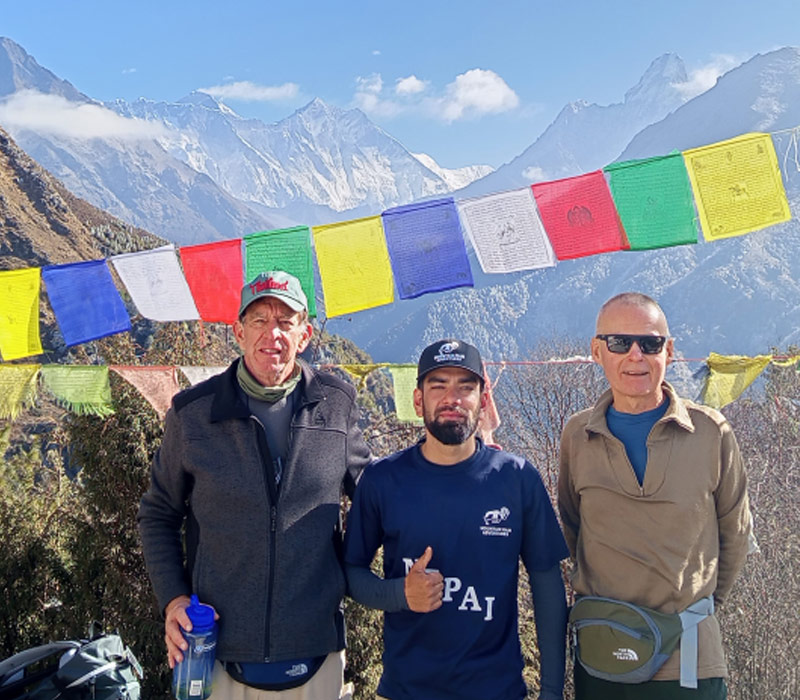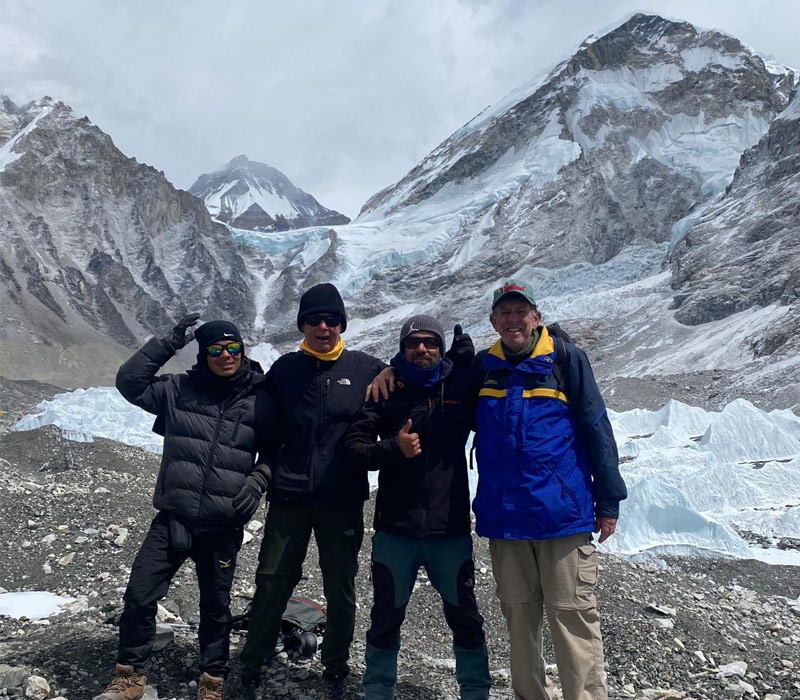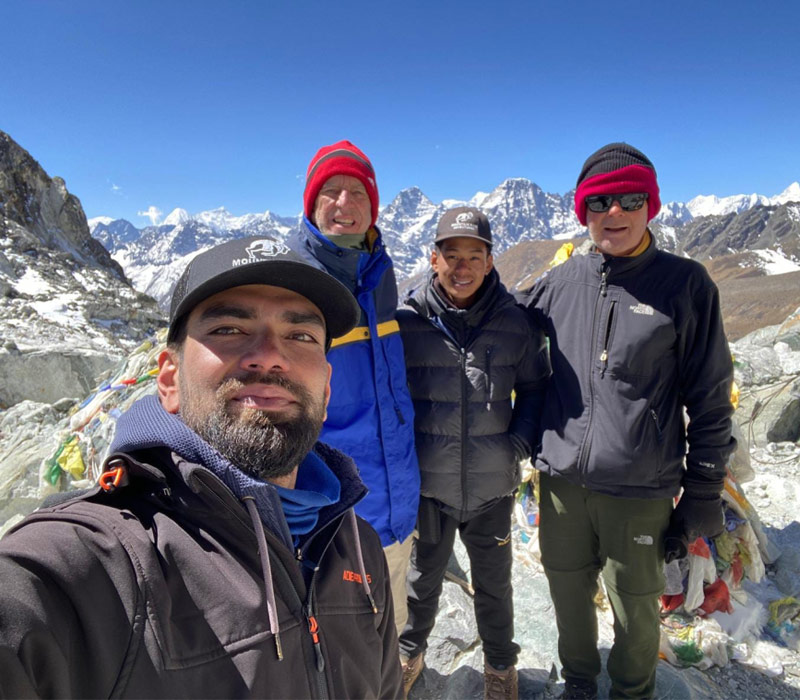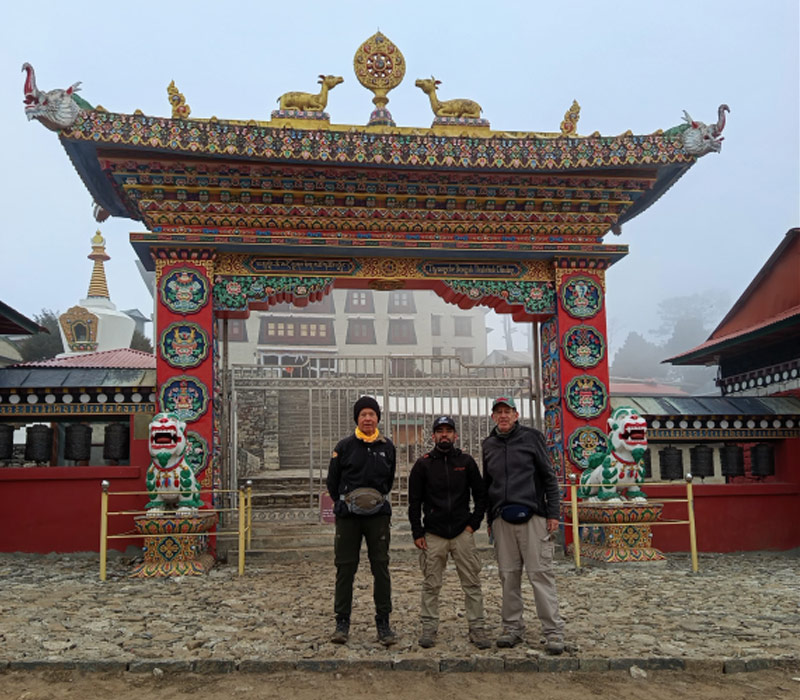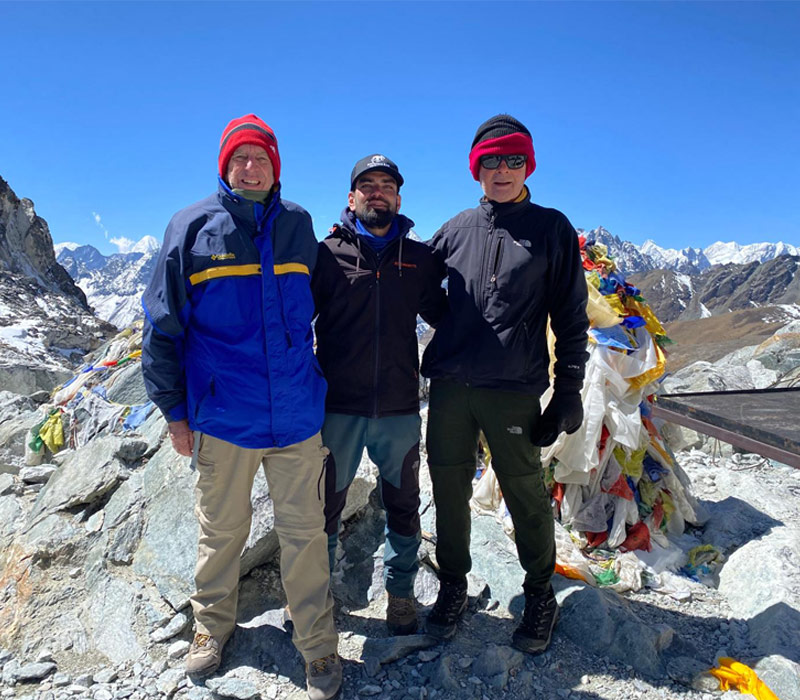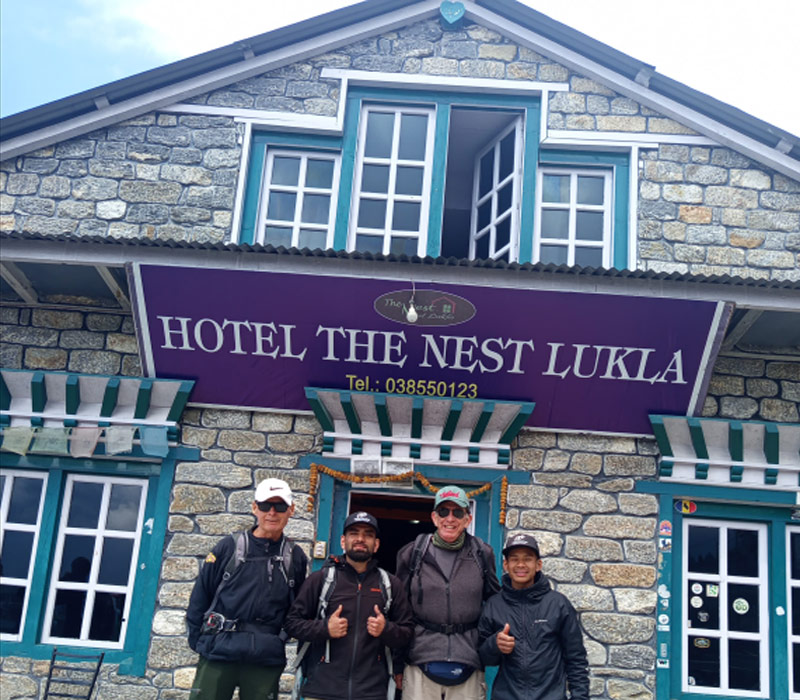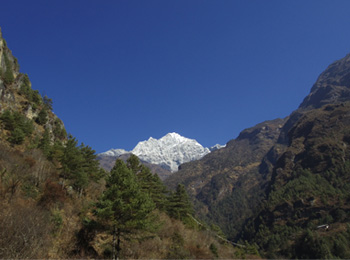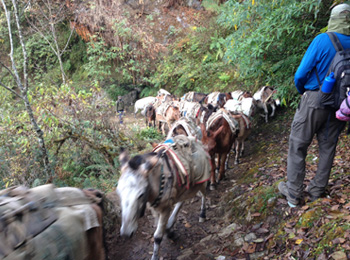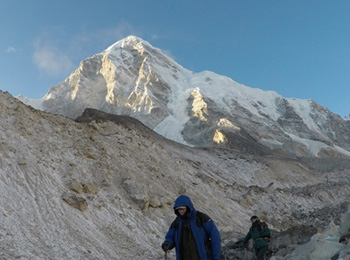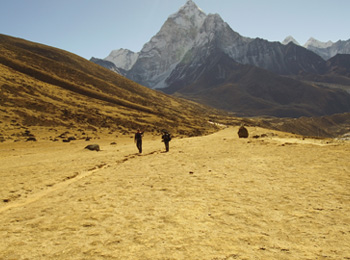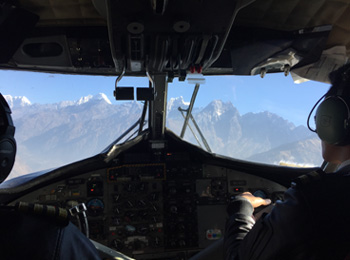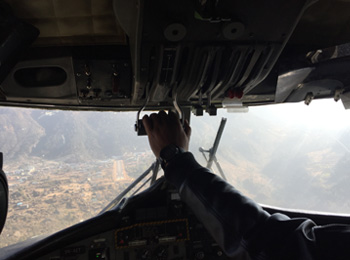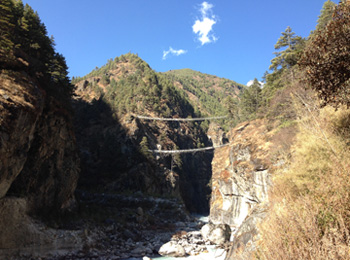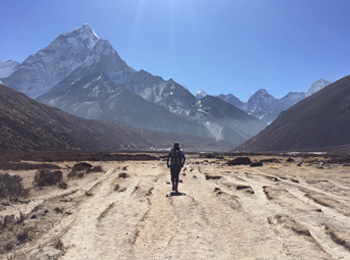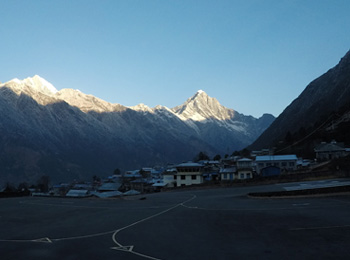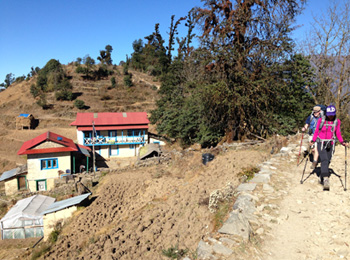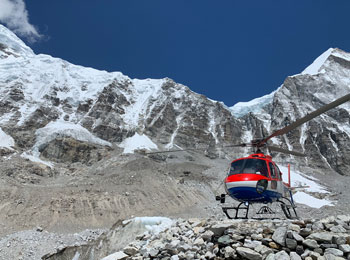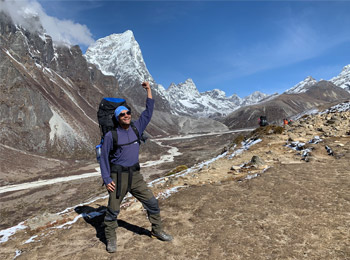- +977 9851074270
- info@mountainramadventures.com
Trip Highlights
- Set your foot on one of the classic trekking expeditions to Everest base camp
- Wander into the glorious Khumbu region inside the Sagarmatha National Park, which shelters a wide variety of endangered floras and faunas
- A picturesque yet thrilling flight from Kathmandu to Lukla that is nothing short of a beautiful teaser of what is yet to come
- Watch many gorgeous sunsets and sunrises as the sun comes up and goes down, painting the mountains in golden color
- Explore Namche Bazaar, the biggest Sherpa town, which is a popular tourist hub full of lively markets, diverse cultures, and friendly locals
- Learn about Sherpas and other local communities
- Reach Everest Base Camp and enjoy a close-up view of Mount Everest from Kala Patthar
- Experience the tranquility of religious communities at Tengboche Monastery (Dawa Choling Gompa) and Pangboche Monastery
- You can also expect museums, libraries, and memorial parks that give you more insights into the cultures and traditions of locals
- Stay at colorful and lively lodges loaded with basic amenities, private rooms, and exotic menus
Detail About Everest Base Camp Trek
It all starts in the beautiful Kathmandu valley, also known as the city of temples. This classic trekking expedition to the Everest Base Camp has made a special place in the life of those who have done it. The journey takes you through many beautiful places in the Khumbu region, from the world’s highest mountains, icefalls, and glaciers to serene monasteries, bustling towns, and teahouses which can be a different experience for each individual.
The Everest base camp trek is the kind of trek no one would ever want to miss if they get an opportunity to do it. But opportunities don’t fall like apples from the tree. You need to create it for yourself, and we, Mountain Ram Adventures, will help you in every step of it.
The Everest Base Camp trekking is loaded with beauty, thrill, and adventure, which is all yours once you decide to do this trek. The Everest Base Camp trail expects you to stand strong and cross all the hurdles to unlock the reward it offers. So now, let us give you insight into what you can expect on this journey.
The abundance of diverse vegetation and faunas inside the Sagarmatha National Park - A World’s Natural Heritage Site
The Sagarmatha national park starts from Monjo village onwards, on the way to Namche Bazaar (3,440 m), and goes up to the top of Mt. Everest (8,849 m). It protects and preserves all the living things & natural wonders in the park. Talking of the vegetation, the lower elevation of Sagarmatha National Park is full of dense and thick pine forests, whereas the higher elevation is loaded with rhododendron, birch, and juniper.
It is home to 118 species of birds and a lot more endangered species of animals, including the Red Panda, Himalayan black bear, Musk deer, Himalayan Tahr, Blood pheasants, and Snow leopard. Then there are rivers, streams, waterfalls, green hills, valleys, lakes, glaciers, moraines, rocky hills, icefalls, gulleys, peaks, mountains, and whatnot.
The tranquility of the Himalayas and its ancient monasteries
While you are in the Khumbu region (also known as the Everest region), you will get to experience the touch of spirituality & the rich culture and traditions of Sherpas. The villages along the Everest base camp trekking route are also resided by other ethnic groups, such as Rai, Lama, Bhotiya, etc. The EBC trek definitely will be a treat for you in terms of interactions with the locals.
Sherpas are the dominant community in the region. They are known for their impeccable climbing skills, strength, willpower, warm hospitality, and traditional wearing. There is a private Sherpa cultural Museum in Namche Bazaar dedicated to the community, welcoming those who want to have a better understanding of their beliefs, practices & norms.
Apart from that, you will encounter many monasteries and spiritual places along the trail, like Tengboche (Dawa Choling Gompa/3,860 m), Khumjung (3,790 m), and Pangboche (3,985 m) monasteries. You can worship and meditate here. Tengboche monastery is the largest monastery in the Khumbu region. The monks will give you blessings for the rest of your journey and well-being.
Side excursion during acclimatization days in Namche Bazaar & Dingboche
While you are in Namche Bazaar, the largest Sherpa village in the Khumbu region, which will also be your first acclimatization spot, meaning you will have enough time to explore the town.
You can visit the school set by Sir Edmund Hillary, Buddhist shrines, and view mountains like Thamserku (6,623 m), Kwangde (6,011 m), Kangtega (6,782 m), Lhotse (8,51 6m), Nuptse (7,861 m), Ama Dablam (6,812 m) and, of course, Mount Everest (8,849 m) during the hike to Hotel Everest View (3,962 m).
Dingboche (4,410 m) is your second acclimatization spot, where you can visit the base of NangkarTshang Peak and gaze upon Mount Makalu (8,463 m) & other surrounding mountains. Dingboche village is known as the summer valley of the Khumbu region, which implies farming grounds. You can see buckwheat, paddies, etc terraces around the village.
The magnificence of the Himalayas and its soothing environment
To soak yourself in nature and its beauty & to experience mindfulness, you need to slow down for a while, turn off your phones and just be there. You will find out that behind these giant mountains, there’s a whole different world out there.
The chirping of birds, the burbling of rivers, the roaring sound of waterfalls, the picturesque and aesthetic landscapes, the crumbling air, and the soothing scent of nature.
You will realize there is more to the Everest base camp trek if you just remember to take deep breaths and slow down now and then while trekking. And our mountain guide will keep reminding you to do so.
Come face to face with the tallest peaks of the world, including Mount Everest
It is no surprise that Nepal is known as the land of mountains for incorporating some of the world's highest mountain ranges. The northeastern part of the country where the trek takes place is home to the highest mountain in the world, Mt Everest (8,849 m).
Likewise, the region also houses the 3rd (Kanchenjunga- 8,586 m), 4th (Lhotse- 8,516 m), 5th (Makalu- 8,463 m), and 6th (Cho Oyu- 8,188 m) highest mountains in the world. You will get to see all of them during the Everest base camp trek, along with numerous other peaks and glaciers.
There are a lot of avid trekkers who consider the Everest base camp trek as a challenge for themselves, and then there are trekkers who want to scale Everest to achieve a sense of accomplishment by proving that they can overcome all the hurdles and get what they set their mind to.
Decide what this trekking expedition means to you and stand face-to-face with the tallest mountains in the world.
Want to make the trip furthermore exciting? Add helicopter return from Kala Patthar
The Everest base camp trek 15 days can get even more exciting than it already is. Some trekkers opt for a helicopter return from Kala Patthar (5,644 m) to either Lukla (2,860 m) or Kathmandu (1,400 m). Let's say you do not have enough time to finish this 15-day-long Everest Base Camp trek or do not feel like trekking back to Lukla, then you can opt for a helicopter return from Kala Pathar and shorten the span of this trek.
Similarly, the heavenly aerial view of the mountains from thousands of meters above the ground is tempting enough to take a helicopter flight from Kala Patthar. You can join a group, which will let you experience a helicopter flight above the Himalayas at an affordable price, or charter a private helicopter as you feel comfortable.
Is Everest Base Camp Trek Worth Doing?
The only answer to this question is YES. Trekking in the Himalayas, that too specifically in the Everest region, is no less than a paradise to be in. You get to live this amazing experience in just 15 days with the magical view, beautiful nature, and fascinating culture surrounding you.
You not only explore the Everest region, the mountains, the culture, and nature, but you also explore yourself as a person. Everything about yourself, including your strengths, your weaknesses, your mental & emotional strength, and much more.
Everest base camp trekking is a must!
Mount Everest Base Camp (EBC) Location and its history
The world’s tallest mountain, Mount Everest, goes by the name Sagarmatha in Nepal and Chomolungma in Tibet. It got its name after the famous surveyor Sir George Everest. Geographically situated at Mahalangur in the Himalayas, Everest is located on the border between Nepal and China.
Everest base camp gained its popularity in 1953 when Hillary and Tenzing scaled it for the first time. Every year thousands of trekkers hike to Everest base camp. The Everest Base Camp Trek also encompasses notable landmarks like Kala Pathar (5,644 m) and Sagarmatha National Park, a heritage site in Nepal recognized by UNESCO.
There are two base camps on Mt. Everest, located opposite to each other in the great Himalayas. One is in the north at an altitude of 5,200 meters in Tibet. The other is in the South at an altitude of 5,364 in Nepal.
Everest Base Camp Trek Length & Terrain
The length of the Everest Base Camp Trek is about 130 km long (65 km each way). It takes around 11 to 16 days to cover the total distance. The most challenging part about the trail is its elevation, which starts from 2,860 meters in Lukla and goes up to 5,545 meters to Kala Patthar.
The typical elevation gain every day ranges anywhere between 400 to 800 meters. Not to forget that you will be walking 15 km up and downhill daily on forested and rocky trails. The terrain of the course is mountainous, with ongoing ascents & descents.
You will walk through dense forests and beautiful river valleys before joining the boulder and rocks-filled course. You will walk past glaciers and moraines too.
Everest Base Camp Trek Preparation
Preparing for the Everest Base Camp trekking 15 days not only includes proper planning of budget, season, itinerary, and packages, but also involves preparing your body and mind for it. An active person can trek comfortably all day without facing any issues. The Everest Base Camp trail is labeled as moderate to difficult, which clearly indicates that it demands an immense amount of physical resilience.
To prepare yourself for a trek like this, you need to train your body by following a fitness regime that comprises a lot of cardiovascular exercises intending to strengthen your muscles and core. Some of the exercises that you can include are running, swimming, jogging, and even short day hikes.
Best Everest Base Camp Trek All-Inclusive Package for 2025/2026 with Local Guides and Sherpas
All our guides and porters are from the Khumbu region itself. This gives them a fair advantage as they're aware of the surroundings. The option of going without a local guide or porter is only applicable to those who have trekked before and can carry 15 to 20 kg a day comfortably while trekking.
However, for a beginner, it won't be easy to avoid all the hindrances on the trail and successfully complete the trek. If you don't want to put your safety into question, you should definitely consider continuing your Everest base camp trek with a company like us that assures local guides and porters with the highest-quality service & best price.
The EBC Trek 2025/2026 Group Trek & Private Trek
Keeping the needs of our trekkers in mind, we arrange both private and group treks based on their preferences. If you are on your own, you can join one of our fixed departure groups or trek with an experienced guide & porter privately. We also arrange group treks, which may include 2 to 12 people or more than that.
So if you are looking for a solo trek or a group trek, let us know in advance. You can contact us anytime to book Everest base camp trek 2025 departure or do an early Everest base camp trek booking for 2026.
Benefits of using Mountain Ram Adventures for EBC trekking
We guarantee the complete success of your EBC trekking expedition with us unless unavoidable circumstances hinders the venture. At the same time, we also assure you of a safe and memorable trek. Being in the industry for over a decade, we hold a lot of expertise.
Our experienced team will ensure that you have the right trekking arrangements, proper gear availability, proper training, and the most comfortable stay throughout the trekking. We promise to offer a secure and easy booking service along with an outstanding customer experience.
Our team is available 24/7 to answer your queries. We not only have a team of the finest guides and porters from the industry who have always got your back and take full responsibility for your safety but also hold exceptional values. These values keep us grounded and aware of our morality.
Let's be Responsible for Our Waste- Clean Travel
We live in such a beautiful world, and it's all thanks to mother nature. No matter where in the world we are, we should know that pollution is the main culprit, which is slowly and steadily killing mother nature. We don't want that to happen to our country or any other country in the world. As a firm believer in Eco traveling, we expect the same reflection from you.
Some of the things we take into consideration while traveling in Nepal are cutting down on waste by going paperless, promoting reusable bags, reducing plastic usage, packing our snacks in reusable containers, saying no to plastic bottles, using eco-friendly toiletries, supporting local businesses, and much more.
You will be traveling consciously with us!
Help us improve our service by giving your feedback
With every trip, we ensure that we are giving the best experience to our customers. Over the years we have helped thousands of trekkers to live their dreams with our initiative, and we are looking forward to achieving even more.
The positive reviews that we get from the trekking community across the globe are always overwhelming for us. However, we believe that there is always room for improvement. With that in mind, we keep conducting surveys to get to know more about our effectiveness in the work.
We would appreciate it if you take a few moments to share your valuable feedback with us, which can help us improve our work even more. You can mail your thoughts to our mail address info@mountainramadventures.com or leave your review on our site.
The Best Everest Base Camp Tours and Alternate Trekking Packages
We have a range of trekking packages that lead to Everest base camp and explore other places in the Khumbu region. Some of our best sellers are Luxury Everest Base Camp Trek, Everest View Trek, Everest Base Camp Trek with Helicopter Return, and Everest Base Camp Helicopter Tour.
Likewise, Everest Three High Passes Trek, Gokyo Lake Trek, Pikey Peak Trek, and Island Peak Climbing with EBC are some other trekking packages in the Everest region.
You can also go on trekking to these destinations- Annapurna Base Camp, Upper Mustang, Mardi Himal Base Camp, Poon Hill, Annapurna Circuit, Manaslu Circuit, Langtang Valley, or Gosaikunda Lake.
Trip Itinerary Expand All
- Hotel
The team welcomes you to the airport. You can see them holding our company's banner at the terminal gate. They will assist you with the luggage and drop you at the hotel in private care. Depending upon your arrival time in Kathmandu, you'll have some rest before before meeting the Mountain Ram Adventures team for the trip breifing.
- Breakfast only
- Hotel
After a long flight you may want to rest before going to this big adventure and the reason you need rest is that you will be starting the trip in the middle of the night to go to Ramechhap which is 4 to 5 hours drive so you should not do much of things this day. Later in the day (after lunch), there will be a short meeting in our office. The trekking guide will say hello to you and give you a short introduction to the trek. You will learn a few tips, and then we proceed with packing. We give duffel bags to the trekkers. The guide will help you buy gear if needed.
- Drive, Flight & 3 hours trek
- Breakfast, lunch & dinner
- Lodge
The Everest base camp trek begins on this day with a morning flight to Lukla. The flight gears you up for the upcoming adventure. Porters join the group once we land at Lukla airport and begin trekking towards Phakding village. Our night stop is Phakding for the day, located a couple of hundred meters below Lukla.
Leaving Lukla, we’ll walk along the Dudh Koshi river. The trail is forested and passes by Cheplung village (2,660 m). From here, we walk past Thado Koshi Gaon at 2,580 m. Crossing multiple suspension bridges, we then hike to Phakding village. Today, we get to see views of Kongde Ri and Kusum Kanguru.
- 6 hours
- Breakfast, lunch & dinner
- Lodge
After having breakfast, we begin trekking through lush rhododendron forests. The trail goes to a village called Toktok (2,760 m) and then passes by Bengkar village (2,630 m). We will cross two hanging bridges to reach Monjo 2,835 m. Here we'll be registering our trekking permits and continue walking inside the Sagarmatha National Park. The trail further crosses many suspension bridges and steeply ascends to Namche Bazaar.
- 4-5 hours
- Breakfast, lunch & dinner
- Lodge
We have a break in Namche Bazaar today. In the morning, we'll hike to Hotel Everest View to witness the first view of Mt. Everest. We also get to see views of Lhotse, Nuptse, Thamserku, Kongde Ri, Khumbila, etc, during the hike. If we feel okay and not too tired, we can continue the hike to Khumjung monastery or return to Namche Bazaar to spend the rest of the day.
The Namche Bazaar is the biggest Sherpa settlement area in the Khumbu region. It is also a tourist hub, and has cafes, pubs, souvenir shops, restaurants, museums, etc. The town is much more bustling than you might have imagined. If you happen to be there on Saturday, then you must attend the Saturday Market.
- 5 hours
- Breakfast, lunch & dinner
- Lodge
The next point of our trek is Tengboche village. Trekking along the rough hillsides, we reach Kyangjuma (3,550 m). The trail then ascends following a zigzag course and then gradually descends to Phungi Thenga (3,250 m). From here, we cross a bridge and walk through the lush forests to Tengboche village. The mountain views are fantastic on the way. We can see a stunning panorama of Ama Dablam, Lhotse, Everest, and Nuptse from here.
- 5 hours
- Breakfast, lunch & dinner
- Lodge
Leaving Tengboche village, we walk on a downhill trail that passes by rhododendron forests to Deboche at 3,320 m. We may come across blue sheep, musk deer, or monal pheasant on the way. Further, crossing a bridge over the Ima Khola, the trail descends to Pangboche village (3,930 m). We cross another hanging bridge and walk past Shomare (4,010 m). Before we reach Dingboche, the trail goes through Orsho (4,190 m).
- 4-5 hours
- Breakfast, lunch & dinner
- Lodge
Another rest day in Dingboche village. The morning has a hike to the base of NangkarTshang, which presents breathtaking scenery of Lobuche, Lhotse, Nuptse, Kangtega, Ama Dabla, and Cholatse. We then spend the remaining day in Dingboche village, resting and mingling with the locals.
- 5-6 hours
- Breakfast, lunch & dinner
- Lodge
Following a steep slope, we walk to Dusa (4,503 m). The trail then keeps ascending towards Dughla (4,620 m). Just before reaching Dughla, we'll cross a bridge. The trail then goes by tombstones and follows another steep uphill route to Lobuche village crossing the Dughla pass (4,830 m). This part of the course involves walking on the glacier. The scenery drastically changes to rocky, barren hills.
- 8 hours
- Breakfast, lunch & dinner
- Lodge
We leave Lobuche village early in the morning and follow a trodden route. The trail ascends along the Khumbu glacier and passes by a place called Pyramid at 4,970 meters, an Italian Research Center. Soon Gorak Shep arrives, and we take a short break and continue trekking toward EBC.
The trail from Gorak Shep goes by alpine ponds, glacier moraines, and glacial streams. The path is steep and rocky. We can see Khumbu Glacier on the way. Upon reaching the Everest base camp, Khumbu Icefall and mountains are seen everywhere. We spend some time at the base camp, then trek back to Gorak Shep to end the day.
- 6 hours
- Breakfast, lunch & dinner
- Lodge
We have one more exciting ascend remaining to Kala Patthar early in the morning on this day. After this, it is mostly a downhill walk with a few minor ascents. So, before sunrise, we hike to Kala Patthar, a viewpoint that offers the phenomenal perspective of Mt. Everest and numerous other mountains all around it. We then trek back to Gorak Shep and retraces the trail up to Dughla before descending to Pheriche village.
- 7-8 hours
- Breakfast, lunch & dinner
- Lodge
The trail descends to Namche Bazaar today. We will be retracing the path back to Pangboche village through terraces and alpine woods. Further, we walk through rhododendron forests to Tengboche village and drop to Phungi Thenga. We keep walking on a winding trail to reach Namche Bazaar.
- 7 hours
- Breakfast, lunch & dinner
- Lodge
From Namche Bazaar, it is a steep descent along rough foothills. Then we enter the forested route and walk past remote settlements. The trail goes through magnolia and rhododendron forests, crossing multiple suspension bridges over the Dudh Koshi river to Phakding village.
Leaving Phakding, we retrace the trail back to Lukla. The trail ascends along the Dudh Koshi river via lush forests. On the way, we will walk past small villages and a cross handful of bridges.
- 35 minutes flight and drive
- Breakfast, lunch & dinner
- Hotel
On this day, we return to Kathmandu after our successful EBC trek. The flight will be early in the morning and offers a stunning mountain panorama. You have the remaining day in Kathmandu leisure. Unpack and have some delicious food as you desire. Go shopping and do all the things you want to do. We meet you in the late evening for a farewell dinner and also give you a trek certificate.
Your Everest Base Camp Trek ends this day. Mountain Ram Adventures team will drop you at the international airport. We will pick you up from your hotel lobby as per your flight departure time. If you have some extra days to explore, then let us know. We have many adventurous and relaxing trips in Nepal.
Note: You are advised to have one or two extra days after the trek because the flight to and from Lukla is uncertain due to the weather.
An elevated point of 5416m. You will be mountain climbing in the main on well established trails. Come and join a Great adventure trip.
Cost Includes
- Pick up and drop off from and to International airport.
- 3 nights hotel in Kathmandu on B/B plan Twin Sharing. (Note: if solo, we will provide single private room in Kathmandu)
- Permits and paper works.
- One English Speaking government Licensed Guide (insured, experienced, salary, food and accommodation)
- Accommodation in tea houses twin sharing
- 3 Meals a day – breakfast, lunch, dinner during the trek (Anything from the menu)
- Fresh fruits every evening. (Only if you hire a porter)
- Flight ticket (Kathmandu/Ramechhap – Lukla – Ramechhap/Kathmandu)
- Farewell dinner in Kathmandu after the trek.
- All taxes and Company service charges.
Cost Excludes
- Bar and beverage bills, Tea, Coffee, wifi, bottled water, desserts, hot shower, Battery charge. Personal expenses, personal clothes, personal insurance for health and evacuation and Tipping for guide and porters.
- Per Porter 240 USD (20 kg weight limit)
Note: You are advised to have one or two extra days after the trek because the flight to and from Lukla is uncertain due to the weather.
Departure Date
| Trip Starting Date 7-Oct-2025 ( 15 Days ) | Price US$ 1330/Per Person | Book Now |
Frequently Asked Questions Expand All
Everest base camp trekking is a moderate trek. The trail gradually ascends via lush forests and terraces to pastures and glaciers. The later part of the trail is much steeper and trodden. Any fit individual can do the Everest base camp trek.
The Everest base camp trail covers 130 km, each side 65 km, approximately. You cover this distance over 12 days of trekking.
The Everest base camp trek varies as per the itinerary and services included in the package. You can expect it to be around USD 1500 to USD 4500.
Yes, a beginner can do the Everest base camp trek. By properly preparing for the trek, anyone can do this trek. Our mountain guides will accompany you during the trek, and make sure you are safe.
Yes, a normal person can go to Everest base camp. Make sure to obtain the necessary permits or join a program organized by a local trekking company to ditch the reservation hassle.
Yes, trekkers usually lose 4 to 5 kgs trekking to Everest base camp. You walk 6 hours a day for 12 days and eat simple meals, which automatically help you lose weight.
The best months to do the Everest base camp trek are March, April, early Map, late September, October, and November. The visibility and weather conditions are best in these months in the Himalayas.
We do not recommend drinking alcohol or smoking at that height because it will dehydrate your body and make you prone to altitude sickness. You may drink alcohol in Namche Bazaar or Lukla while returning from EBC.
No, you will not sleep at Everest base camp because there is no lodge or tea house available. The last accommodation is available in Gorak Shep. You can only see mountaineers with their tents on the base camp.
No, you do not need a tent for the Everest base camp trek. The trail has very nice accommodation facilities available. Depending upon your budget, you can get a budget-friendly or luxury lodge for yourself.
No, there is no WiFi at the Everest base camp. But, you can use the internet by utilizing a Nepali sim called Ncell.
Everest base camp temperature ranges from 22 degrees Celsius to -5 degrees Celsius. The morning time is much more bright and stable than evening & night.
In the peak trekking seasons, the Everest base camp trekking route does get a bit crowded. However, it has its own charm. You can see people from around the world in one place. And magically, every individual has a distinct experience and gets tranquil moments.
The oxygen level at the Everest base camp is between 85% to 87%. The temperature at sea level is between 98% - 99%.
No, there are no shops at Everest base camp. The last tea shop is in Gorak Shep.
Useful Information
Itinerary Disclaimer
Our goal is to follow the itinerary unless an odd event demands a change in it. For instance, if we see any sudden weather fluctuation, political disturbance, or natural calamities, we will do the necessary change in the itinerary (if only needed). The group leader will make decisions by corresponding with the office team, making sure to maintain the interest of the trekking members.
Airport Pickup & Drop
If you are booking with us, then you do not need to worry about the pick-up and drop from the airport. It will be taken care of by the team members of Mountain Ram Adventures. The moment you reach the Tribhuvan International Airport, our representative will pick you up from there and take you to your hotel. The same goes for the drop facility.
Safety and Security
When it comes to such an adventurous journey, safety and security become a priority for everyone. Trekking to Everest base camp not only includes walking on rugged trails but also includes high-altitude locations, most of which are above 3,000 meters. That is why we have designed the itinerary in such a way that trekkers get enough time to acclimatize and avoid altitude sickness.
Our experienced trek guide will ensure your safety all the time on the trail. While we, as a trusted and reliable tracking agency, take complete responsibility for your safety and security, there are several things that you should take into consideration before your trek.
You need to make sure that you are packing luggage according to the requirement. Our team will be carrying a first aid box all the time in case of emergencies. As for your luggage, it will be taken care of by our porters.
Minimum Age
There is no strict age restriction as such for the EBC trek as long as you are physically fit and healthy without any serious health issues. To make this more clear, we want to tell you that children about 7-8 years and elders about as old as 80 years have completed this trek with our company.
So it is all up to the guardians of children and elderly people to ensure that they are fit and in good shape to be able to take part. Since the guides and porters nearly take care of everything, all they need to do is focus on climbing.
Solo Travelers
You cannot do Everest base camp trekking on your own now. The Nepal Tourism Board has updated a no-solo trekking rule on every trekking trail in Nepal. It means you necessarily have to trek with a guide. This is done to minimize the casualties seen over the last few years among solo travelers in the mountain.
You can hire an independent guide or join us on our 2025/2026 EBC trek departures. You can also do a private trek with us, which allows you to trek on your own terms.
How much Money do I need for Everest Base Camp Trek?
There is no definite answer to this question as the Everest base camp trek cost can vary from agency to agency and the duration of the trek. To know more about our budget for this trek, which won’t be a burden on your pockets, we promise, you can either give us a call or mail us.
This cost will include a lot of your expenses like a Kathmandu/Ramechhap -Lukla and back flight, local transport, entry permits for Sagarmatha National Park Entry Park, a guide and porter for 12 days, 11 nights of accommodation in lodges, and a lot more. Likewise, you will need additional money to do shopping, cover your personal expenses, buy international flight tickets, etc.
Accommodation on the Everest Base Camp Trek
For most of the journey, you will be staying in lodges. These are run by the locals. You will find a room with two separate beds, a comfortable mattress to sleep on, and a common washroom.
The lodges have a common area (that generally is a dining area) where you can sit and share your experience with fellow trekkers. On top of that, the warm hospitality of lodge owners will make you feel a lot more comfortable. The accommodation will be simple but cozy.
Food on the Everest Base Camp Trek
The meal option is quite decent on the Everest base camp trekking route. You will get to have many different dishes and snacks. All the lodges along the trail offer a long list of food times on their menus, ranging from Nepali dishes to Tibetan, Continental & Indian.
Dal Bhat is the super meal. Affordable price has lots of flavors, keeps filling, and is the freshest option on the menu. Dal bhat is eaten by Nepalese all over the country at least in one of their meals each day. Boiled drinking water is also available in all the lodges.
*Note: Do not drink directly from tap water or streams. It can give you an upset stomach.
Flights to Lukla, the start of the Everest Base Camp Trek
Kathmandu Lukla flight is very famous. Lukla is a small airport at 2,860 meters above sea level. The runway is short and can only welcome aircraft such as Pilatus PC-6 Turbo Porters, DHC-6 Twin Otters & Dornier Do 228s.
- Kathmandu airport to Lukla flight: Lukla is the starting point of your Everest Base Camp trek that includes a 35-minute short flight from Kathmandu, taking you through a scenic journey that is nothing sort of a visual blessing for your eye.
- Manthali airport, Ramechap to Lukla flight: Sometimes due to high air traffic, you may not be able to take the flight from Kathmandu Airport. In such cases, the flights get shifted to Manthali airport, located a 4 to 5 hours drive away from Kathmandu. From here, it will only take 20 minutes to reach Lukla.
- Hiking to Lukla from Kathmandu: You can also use a car, jeep, or van to drive to Phaplu or Jiri and then hike to Lukla to continue the EBC trek. It's completely up to you to pick one option that fits right in your budget and time constant.
Everest Base Camp Trek Permits
To do Everest base camp trekking, you need two permits. Our Everest base camp trek cost covers both permit costs and is obtained by the team members on your behalf.
Khumbu Pasang Lhamu Rural Municipality Entrance Permit - NPR 3000 Per Person
Sagarmatha National Park Entry Permit - NPR 3000 Per Person
Do you need a TIMS permit to trek to Everest Base Camp?
Earlier, you needed a TIMS (Trekker's Information Management System) permit for trekking in the Everest region. But from October 1st, 2018, it is no longer necessary to carry a TIMS card. You will only need two permits, and those are Khumbu Pasang Lhamu Rural Municipality Entrance Permit & Sagarmatha National Park Entry Permit to trek in the Khumbu region.
Everest Base Camp Trek Difficulty
Well, the answer depends on who is asking this question. If you have done trekking, then you won’t find it hard. But if you are a beginner with no prior trekking experience, you may find the Everest base camp trek a little tough.
The trekking difficulty level is marked moderate by the professionals. So keep in mind that this moderate trek is 130 km in length, which is 65 km each way.
Another factor that can contribute to the difficulty of EBC trekking is the walking duration per day. You will be walking for 6-7 hours a day. Likewise, do not forget the altitude, as you will be gaining higher altitudes every other day.
So, in conclusion, the only thing that can ensure the success of your trek is your physical and mental fitness. Yes, mental too. After all, you don’t want to give up midway through your trek, assuming you can’t go any further.
Best time to trek Everest Base Camp
The weather in the Himalayas is highly unpredictable, and before you start trekking, you need to decide the right time for it. After all, you don't want to end up in a bad situation. Weather can not only ruin your experience but can get you into trouble as well.
If we had to tell you the best time to go for the Everest base camp Trek, then it would be the spring season, which lasts from March to early May, and the autumn season, which lasts from late September to November in Nepal.
Everest Base Camp Trek in Autumn
Autumn is the best trekking season in Nepal, lasting from late September to November. The weather in autumn is extremely pleasant. The weather is stable most of the time and the temperature ranges anywhere from 25 to 30 degree Celsius. The trails in this season are always crowded not only with trekkers but also with gorgeous rhododendrons & other wildflowers.
Everest Base Camp Trek in Spring
Spring arrives with its beautiful rhododendron blooming everywhere on the trail. The temperature is stable and generally ranges anywhere between 16 to 25 degrees Celsius. Sometimes the temperature drops to 0 degree Celsius at night, so considering everything, you need to pack your stuff wisely. Plus, there are no clouds to stop you from viewing the beautiful snowy mountains.
Everest Base Camp Trek in Summer/Monsoon
Summer and monsoon in Nepal go hand in hand. The time between late May to August & September is quite confusing as the weather is hot and wet at the same time. This season lasts from July to mid-September and is not recommended for trekking. You will face a hot temperature, occasional rain, and thunderstorms.
If you decide to go on your trekking journey during this time of the year, you will face a muddy, slippery & wet trail, which of course, is not ideal. However, you may consider the early or late months of this season, which are somewhat appropriate for trekking. However, you have to plan very carefully.
Everest Base Camp Trek in Winter
Finally, it's time for the frosty winters, which knock on the door in November and won't leave the house till February. The season is extremely cold, and the temperature reaches around -26 degrees celsius and can go down even below -40 degrees in the upper part of the Khumbu region.
The days are still comparatively manageable, but the nights and mornings are extremely cold. The temperature in the lower elevation ranges from 9 to 12 degrees Celsius, but as the altitude increases, the cold gets even worse. With proper preparation and the right timing, you can do the Everest base camp trek in winter.
Everest Base Camp Trek Tips
A fair warning! These are not just basic tips but life savers during the trek that we are about to disclose.
Internet
You can either get a sim and pay for data packages, or you can access the WiFi from the lodges at an additional cost. You can also buy WiFi cards which can be a little expensive, but it has more benefits than any other option.
Hot Shower
Hot showers are available at every lodge as you trek. But it comes at the cost of a few extra bucks that is not covered by the package cost. It can cost you anywhere between 2 to 5 USD, depending on the elevation. The lodges only provide enough warm water free of cost to wash your face.
Charging
Of course, by the time you cover one-fourth of your journey, your battery will run out of energy. So now what? Well, there is nothing to worry about as the lodges are equipped with the facility of a charging station where trekkers can pay some amount and charge their gadgets.
*Note: Just to be extra prepared, you can also carry power banks or spare batteries.
ATM
ATM is available at Namche Bazaar, but above that, you won’t find any ATM. Withdraw ample Nepali cash to use while trekking.
Luggage
We use an 80L duffle bag to pack all the heavy trekking luggage. It is carried by a porter if you hire one. Keep in mind that the weight limit of a duffle bag should not exceed over 10 kg per trekker (total 20 kg for one porter). Trekkers can use a daypack to carry the stuff that they may need frequently (water, camera, snack, or other personal items).
The weight of the day pack should not go above 5 kg. The extra suitcases you can keep in the locker of your hotel room. Don’t worry, it won’t cost you any additional money.
Guides and Porters on EBC
There are two ways for hiring a guide and a porter. You can hire independent guides and porters, that is, if you are going on a trek without a trekking agency. Then it becomes your responsibility to ensure that the pair is experienced, speaks English fluently, and not charging you more than required.
On the other hand, if you are choosing a trekking agency like us, you need not worry about anything as all our guides and porters have been in the field for over a decade now.
Tipping the porter and guide on EBC
There is no mandatory rule on tipping the guides and porters. However, it is only the right thing to do if you tip some amount as a form of appreciation for their hard work. They work extremely hard by carrying your heavy luggage on the trail.
Insurance for the Everest Base Camp Trek
Let us not think too much as to what can go wrong while you are on a trek. However, at the same time, it is also not wise to ignore precautions while trekking in the Himalayas. You may need a sudden helicopter evacuation in case of emergency. For a situation similar to this, getting insurance will save you from trouble and cover a lot of expenses.
It won’t take much time to buy one, and you can get it online. Also, look carefully for the coverage it provides. Your travel insurance should at least provide coverage against your accidents and medical expenses. It should also cover air evacuation up to 6000m elevation, trip cancellation, gear loss, or any injury.
Risks During Everest Base Camp Trek
The main risk involved in the EBC trek is related to altitude sickness. However, there are also few chances of earthquakes or landslides in monsoon, but that is extremely rare and doesn't pose much risk to trekkers.
Below are some of the ways to prevent altitude sickness. The reason we say prevent and not avoid is that anyone can face altitude sickness regardless of their physical fitness.
Preventing Altitude Sickness (AMS) during the hike
Know that the moment your body reaches an elevation above 2,500 meters, where the air gets thinner in density, you will start feeling the symptoms of altitude sickness, also commonly referred to as acute mountain sickness.
We have designed our Everest base camp trek itinerary in such a way that you get two days of acclimatization in your complete journey, so your body can rest and get used to the altitude.
If you are getting nauseous, vomiting sensations, tightening in your chest, severe headaches, dizziness, poor appetite, difficulty in walking, body aches, coordination problems, weakness, or shortness of breath, then it's a sign that you should stop informing your trek guide about it.
Below are some of the ways to prevent acute mountain sickness.
- Eat healthy food
- Drink above 4 liters of water per day
- Avoid alcohol consumption
- Avoid eating meat while you are on a trek
- Climb high sleep low
- Walking at a slower pace
- Don't have more than 500 meters gain in elevation in a day
- Listen to your body
- Share it with your trek guide
Stomach problems on the EBC trek
Keeping your tummy healthy and happy becomes very important once you are on a high-elevation trek. Ensure that you are consuming healthy food and clean water. Try not to consume any meat. Do not drink water directly from the tap or stream.
Personal Expenses
Your expenses will usually be the cost that is not covered in your package. This include:
- Nepal Visa cost
- Cost of Wi-Fi/cellular data during the trek
- Tips for guides and porters
- Cost of hot showers during the trek
- Emergency treatment and evacuation
- Excess baggage charges at the airport
- Cost of charging during the trek
- Flight delay cost
- Insurance cost
- Other miscellaneous expenses like shopping, souvenirs, snacks, hot and cold beverages, etc.
Emergency Contact
You may or may not need an emergency contact, but we think it is necessary that you have at least one or two of them for communication. You can contact us at +977 9851074270 or email your queries at info@mountainramadventures.com for any time for any support. Our Whatsapp and Viber are also at +977 9851074270 this number.
Visas and Entry Requirements
You can apply for a Nepal visa upon your arrival at Tribhuvan International Airport. All it takes is your passport, application form, and a passport-sized photo. The whole procedure will take about an hour, and you can pay in US dollars, and voila, your Nepal visa is with you. Likewise, you can also obtain an on-arrival visa at the land borders.
*Note: Citizens of some countries do not qualify for an on-arrival visa, so they have to get it from the Nepalese Embassy in their country or Consulate Office.
Laundry
Since it is a 15-day long Everest Base camp trek, you need to pack your clothing accordingly. The laundry services are available only at the lower elevations. You can avail of these services in Lukla and Namche Bazaar, but above Namche Bazaar, you won't find any laundry services. So, it's better to carry enough clothes to last you while trekking and get it all cleaned after coming back to Kathmandu.
Money Exchange
You will need cash most of the time while dealing with local vendors, personal shopping, or even while tipping your guides and porters, as they will not accept foreign currencies. For such use cases, you need to have Nepali currency, which is called Rupees. Especially during the trek, you cannot use your cards to pay for services.
You can either do a money exchange at the airport at the moment you arrive in the country or at banks/money exchange centers in Thamel or Namche Bazaar.
Emergency Funds
You need to keep some emergency funds for those times when the situation doesn't go as planned. You will need it when there is some last-minute flight cancellation or a sudden change in plan that requires additional days of stay at the hotel. So to cover the expenses of your accommodation and food, you can make good use of your emergency fund.
Learn Useful Nepali Phrases & Etiquette
Namaste! Now is the time to learn a few useful phrases that will help you immensely to break a conversation with a local. We’ll keep it short and sweet. Let’s do the greetings first, shall we?
- Hello/Goodbye – Namaste
- Is everything okay? – Sabae thik cha?
- I’m okay– Ma thik chu
(yes, the only difference is the way you say it!)
- My name is ‘XYZ’ – Mero naam ‘XYZ’ ho
- Good morning – Shubha-prabhat (we say good morning in general!)
- Good night – Shubha-ratri
- Thank you – Dhanyabad
- You’re welcome – Swagatum
- Please – Kripiya
- Pardon? – Hajur?
- Can I take your photo? – Photo khichnu huncha?
- Beautiful – Ramro
Packing Tips
When you are packing for trekking, you want to make sure that you are not missing out on anything and keeping all the important stuff with you, which includes your essentials, non-essentials, edible items, gear & equipment, necessary documents, insurance, daypack, backpack, clothing, personal kit, medical kit, electronic gadgets, etc.
*Note: You can rent most of the trekking clothes and gear in Thamel.
We have arranged a refined list of all the items that fall under each category:
- Essentials: Daypack and rain cover, backpack and rain cover, Duffle bag (provided by the company), Water bottle, water filter, Sleeping bag & liner, Trekking poles, Stuff sack, Raincoat, rain pants, Clothing (4-5 pairs of each item), dry tees, Cotton socks, woolen socks, Underwear, Trekking shirt and pants, Hiking shoes or boots, Down jacket, fleece jacket, windbreaker, Thermal wear, Sun cap, scarf, gloves, Woolen cap, hat
- Personal kit: Sanitiser, Wet wipes, Sunscreen, Lip balm, Cold cream, Face cream, Toothbrush & paste, Hand wash, Toilet paper, Soap, Shampoo, Comb, Sunglasses
- Personal Medical kit: Band-aid, Cotton, ORS or electoral powder, Antiseptic cream, Bandage and spray for sprained joint, Paracetamol, Vomistop, Antifungal cream, Insect repellent, necessary medications
- Electronic Gadget: Spare batteries, Power Bank, Charger, Camera, Headlamp/LED torch
- Documents: Identity card, Insurance, Permits, Passport, Visa, Photo
Trip Review
I would like to extend my deepest appreciation to Mountain Ram esp to our guide (Krishna & Mahesh) and porter for their exceptional service during our Everest Base Camp trek. The journey was challenging, but our guide's vast knowledge of the terrain, weather, and local culture, combined with his positive attitude and encouragement, made it an enriching and enjoyable experience. Our porter's incredible strength, efficiency, and friendly nature were invaluable, as he ensured our belongings were always safe. I can say they formed a seamless team that allowed us to focus on the breathtaking beauty of the Himalayas and the thrill of the adventure. Thank you both for your hard work, and dedication and for making this trip truly unforgettable.
"Mount Everest Basecamp"
I was so lucky to meet Ram and the rest of his company when I was traveling in Nepal. Me and 3 other danes wanted to go to base camp. Ram and his guys helped us with everything. We just enjoyed the trip and all the time you had a feeling that you were in good and safe hands. Also when we actually needed the help, when my friend got sick, they took care of everything. I can with all my heart recommend to book your trip at this company. The are more than just good guides, the really put in an effort to make sure that you get a good experience. And of course I recommend to go to base camp, it is one of the best experience in my life.
Visited February 2014
Posted Date : 2014-03-25 12:44:26
"We are coming back again!"
My brother and I went trekking to Mount Everest Basecamp in October 2013. It was the most amazing experience! Everyone who goes to Nepal has to do it. Therefor it is very important to choose the right company = Mountain Ram Adventures :) Everything was organized and we could just enjoy. The price is reasonable and worth every single penny. Ram and his local guides are very professional, but you will also have a lot of fun! We had a great time, we never will forget. If you read this do it and chose Mountain Ram Adventures, you will never regret. We became friends with Ram and are still in contact. I know that we will be back one day.
Visited October 2013
Posted Date : 2014-03-25 12:40:22
"Everest Base Camp Trek in May 2013"
My friend and I did a last minute booking for Everest Base Camp with Mountain Ram Adventures and Ram Sharan Upreti was great in helping to give us advice on what suited our interests. What I appreciated was he was extremely fair in his prices and super personal. He was gracious enough to always offer the best tea, and even showed us some local gems around his office. During our trek, our guide was ok - but we worked with Ram Sharan Upreti who took swift action to make it better. Overall, I would recommend Mountain Ram Adventures and highly recommend Ram Sharan Upreti.
Visited May 2013
Posted Date : 2014-03-25 12:30:20
"Mount Everest Basecamp"
Min rejsegruppe og jeg havde en fantastisk oplevelse med Mountain Ram Adventures. dygtige, professionelle og loyale guides og arrangør (Ram). God pris for trekket og alt gik perfekt, vi kunne bare læne os tilbage og nyde turen til fulde. min veninde fik højdesyge og Ram (ejer af firma) og vores guide tog sig af alt det praktiske med helikopter, sygehus og forsikring. Vi følte os meget trygge hele turen op. kan varmt anbefale dette trekkingbureau. de er for seje!
Visited November 2013
Posted Date : 2014-02-12 07:29:35
"Loved Everest Base Camp trek !"
We enjoyed our trip to Everest Base Camp. Unfortunately we had to be evacuated by helicopter from Dingboche after a week because Ton sprained his ankle. Our guide Rames and Ram\'s agency organised everything very well. We were very glad they were there to help ! Visited on December 2013
Posted Date : 2014-02-12 07:23:07
"Ram knows Nepal like Michael Jordan knows basketball"
I was in Kathmandu for the first time with a friend of mine, where we luckily encountered Ram. He was immediately willing to help us and show us our options for the length of stay that we had (6 days), and he was really nice too! If you want to do a trek, go white-water rafting, see Mt. Everest via plane, explore ancient temples or do a bunch of other cool things in Nepal, this is the man to go to. Thank you again Ram!
Visited February 2013
Posted Date : 2014-01-13 07:11:29
"Are you looking for a once in a lifetime trekking experience with unforgettable memories?"
I recently did the Everest Base Camp trek and Langtang Gosiankunda trek with Mountain Ram Adventures and I would like to say a BIG thank you to Ram Sharan Upreti for organising both of my treks. For providing outstanding service, unforgettable lifetime experiences and the best treks I have ever had from start to finish. Ram helped me to personalised both the Everest Base Camp trek and Langtang Gosiankunda trek and it was like discussing my trekking plans with a friend. Ram is knowledgeable and was able to assist me with all enquiries I had, both before and during the trek including when I was experiencing a mild AMS. As a single trekker, Ram had chosen a guide who I got on well with, it felt like I was trekking with a friend in safe and experienced hand. Mountain Ram Adventures team are confident, knowledgeable & very safety conscious. They will provide you with an amazing experience just as I have had whilst completing the Everest BC trek and Langtang Gosiankunda trek. If you are considering trekking in Nepal, you will not be disappointed if you choose Mountain Ram Adventures as this company is the one I would recommend to my family and friends. Thank you once again Mountain Ram Adventures for the unforgettable memories, I hope to see you all again when I am next in Nepal. Visited December 2013
Posted Date : 2014-01-13 06:27:49
Ich habe an einer durch Mountain Ram Adventures organisierten Trekkingtour zum Everest Base Camp und nach Gogyo teilgenommen. Die Tour wurde durch Rames geleitet, der uns sicher selbst durch schwierige Passagen wie dem Cho La Pass gefuehrt hat. Wer all den Weg zum Everest Base Camp macht, sollte ein paar Extratage für Gokyo auf dem Rückweg vorsehen – die Landschaft ist einfach phaenomenal. Ram (der Firmenbesitzer) hat sein Buero im Touristenzentrum von Thamel in Kathmandu. Er ist stets bemueht alle Wuensche zu erfuellen und klaert alle offenen Fragen. Beim Everest Trekking ist es wichtig einige Ruhetage zur Akklimatisierung einzuplanen um der Hoehenkrankheit vorzubeugen. Ram sieht diese Tage im Ablauf vor und haelt sich auch strickt daran. Dank dem konnten wir alle Ziele erreichen ohne krank zu werden. Falls noetig organisiert er auch Dauenjacken, Schlafsaecke etc. Dies gab mir die Moeglichkeit mit wenig Gepaeck nach Nepal zu kommen da ich danach in waermere Laender weiterreiste. Seine Tour bietet einen Tuer-zu-Tuer Dienst – Das heisst, der Guide holt einen am ersten Exkursionstag im Hotel ab, arrangiert alles am Flughafen und begleitet einen auf der gesamten Exkursion bis zurueck zum Hotel. Die Touren beinhalten die Verpflegung, Bewilligungen, Unterkuenfte etc. Einzig für die Getraenke und Snacks für zwischendurch muss man selbst aufkommen. Sehr gefallen hat mir die Wahl der Zimmer in den Bergunterkuenften. Rames hat stehts die Zimmer mit der besten Aussicht organisiert – einfach traumhaft :-) Zusammenfassend hatte ich einen sehr guten Eindruck von Mountain Ram Adventures, der ehrlich auf offene Fragen antwortete und wenn noetig stehts erreichbar war. Die Exkursion war sehr gut organisiert und ich freue mich schon auf weitere Touren beim naechsten Besuch in Nepal :-) Ich kann Ram´s Dienstleistung nur empfehlen – Vielen Dank fuer die tolle Zeit.
Posted Date : 2013-09-29 08:37:02


